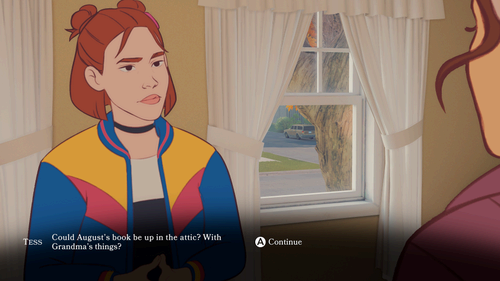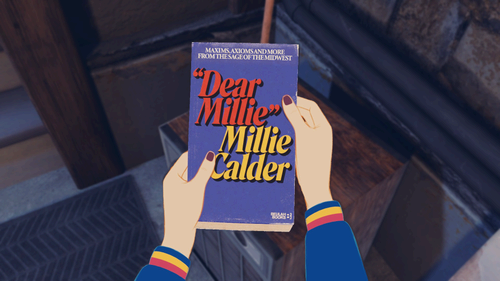I own a jacket that’s eerily similar to Tess’ in Open Roads. It’s a blue bomber with yellow and burnt orange accents, and it’s not the only thing that Tess and I have in common. As she leisurely explores her childhood bedroom in the first few minutes of the game, Tess comes across set pieces that ground her environment in the early 2000s. There’s a chunky black television set and scattered DVD cases, little bottles of bright nail polish, a black-and-white strip from a photo booth, newspapers remembering 9/11 and hunting for bigfoot, and a bright pink tube of sickly sweet lip balm. These are the leftovers of her adolescence — the room is disheveled and largely empty, with most of her possessions packed away, ready to move. Tess picks through the room’s remaining photos and yearbooks, her hand-drawn fingers reaching out to interact with 3D objects, revealing more of her backstory with each touch. The cuff of her jacket is jarringly familiar every time it enters the frame.
Open Roads is a narrative-driven, exploration-focused game about the road trip that Tess and her mother take when a death in the family uproots their life. After clearing out the house and finding a mysterious diary in the attic, Tess and her mom, Opal, print out directions from RoadBuddy (not MapQuest) and set off on a long drive. Emotional upheaval is bound to ensue.


I watched developers play the first 15 minutes or so of Open Roads, and the preview reeled me in immediately. Visually, the game is polished and engaging; the settings and interactable objects are 3D, while characters are hand-drawn, carving depth into each scene. Developers at the Open Roads Team uploaded real-life handwriting samples to create yearbook pages, postcards and letters, which removes the threat of pixelated text ruining the immersion. In conversation, the characters float between movements like old-school Disney storyboards, making the entire experience feel like a lucid dream.
Tess and Opal are fully voiced by two mainstream actors, Kaitlyn Dever and Keri Russell, and in the scenes I’ve seen, their performances are fantastic. The interactions between Tess and Opal are simultaneously loving and strained, as mother-daughter relationships can be. The writing is also evocative and genuine; dialogue flows smoothly, even with the various player-chosen paths that each conversation can take. These characters feel real right away.


The house that Tess and Opal are leaving is lived-in and it has a sense of history. There are personal, hand-crafted touches in every room, and developers added bits of their own lives to the game. The chair by that desk? It was modeled after a developer’s own childhood memories. Those old, creepy ornaments in the attic? A developer’s grandma passed down those exact decorations in real life. The scribbles on the wall? They’re drawings from the creators’ kids. These details won’t be obvious to most players, but they lend a sense of authenticity to the game as Tess explores the closets and corners of her family home.
Open Roads doesn’t just provide early-2000s nostalgia, but it also reaches back and references the ’60s and ’70s, covering multiple generations in Tess’ family. As Tess investigates the house and picks up various objects, Opal provides context and tells stories about their life, and there are branching dialogue paths. At one point during the preview, the developer that was playing decided to make Tess walk away from the refrigerator without shutting its door, and this caused Opal to scold her. Tess and Opal’s relationship is charming and warm, but there’s a sense of tension running through their interactions that I’m eager to examine in the full game.
Open Roads feels like a mix of Gone Home, Life is Strange and What Remains of Edith Finch, in the best possible way. The writing, voice acting and animation style harmonize in the first few minutes of the game to create a realistic and nostalgic world populated with vivid characters. I’m ready to hit the road with Tess, Opal and their printed-out driving directions when the game hits PC, Switch, PlayStation and Xbox on February 22. After all, I already have the jacket.

